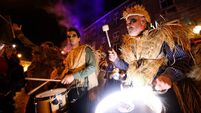Killer queen! Cork in frontline of battle to stop Asian hornet

Avoiding them wasn’t an option for the National Parks and Wildlife Service (NPWS) rangers and entomologists, who spent some of the summer in Cork trying to get as close as possible to two Asian hornet nests.
The initial sighting of what looked like an unusual wasp by a sharp-eyed citizen led to the discovery of a nest in Ballintemple, and another in Cobh.
The moment of curiosity that led to a photo being submitted to www.invasives.ie set off one of Ireland’s most impressive insect investigations. Within weeks, a team had tracked and removed both nests, a first for Ireland.
When I heard the commotion over the summer, I picked up the phone. As a presenter and producer of RTÉ’s science show , we were already filming an episode themed around invasive species, and this was too perfect and important a story to ignore.
I asked if our team could tag along with the NPWS and we were invited to see the hornets’ nests up close in the lab once they had been safely stored and frozen for several weeks.
Originally native to China, Vietnam and parts of India, how did the Asian hornet end up in non-exotic Cobh?
The first adventurous Asian hornet came to France about 20 years ago, probably hitchhiking in imported cargo from Asia, and then spread quickly, gaining a foothold across the continent.
A single pregnant queen can establish a new colony, and as we’ve seen, trigger an impressive rapid taskforce response to eradicate that colony.
We are worried about Asian hornets because they are predators of other insects and Ireland’s native insects are already in trouble.
Anyone who has left a window open on a summer night will have noticed the eerie absence of ‘midgety yokes’, to give them their formal nomenclature, flitting around the lightbulb.
Once, moths and midges swarmed around a light at night, but it’s not a common scene anymore. Habitat loss, pesticides, and climate change have all contributed to a steep decline.
Initiatives such as the All-Ireland Pollinator Plan are working to reverse this, but the arrival of a new predator could easily undo any progress.
A single hornet can kill and eat up to 50 honeybees a day. With a hornets’ nest containing up to 6,000 hornets, you can do the maths on how quickly a honeybee hive would be decimated.
That’s why the response in Cork mattered so much.
The rapid reaction, from a citizen’s smartphone snap to the NPWS field teams on the ground, was an exemplary case of how science and public vigilance can work hand in hand.
Aidan O’Hanlon is the entomologist with the National Museum of Ireland who was on the ground tracking the hornets. Using sugary feeding stations and tracking their flight paths, Aidan and the team were eventually able to triangulate the nest 20 metres up a sycamore tree.
I struggle to find my second glove most days, so ecological detective work like this is seriously impressive to me.
If you tune into the next episode of next Monday, you’ll get a fascinating insight into the dismantled nests. They are beautiful constructions with layers of combs and hornets at every stage of the life cycle: larvae, pupae, newly emerged adults.
Compared to our native wasps, the hornets are much larger and have elegant yellow legs which make them so distinctive.
Aidan O’Hanlon’s research focused on examining the structure of the nest, counting and categorising the insects inside, and what stage of the life cycle they were at.
The good news is the nests didn’t contain males or new queens. New queens are produced in October so it is great that the nest was removed before the next generation began.
Aidan is also interested in analysing what the larvae were fed to determine what species of Irish insects the hornets were feeding. About 40% of hornets’ diets are honeybees but 60% is of other native insects (if the hornet is hoovering up other species, it’s good to know what ones).
In time, these hornets will also be sent for DNA analysis to determine their lineage - are these Asian hornets descendants of that hornet who arrived in France 20 years ago, or a new introduction.
In March or April, she made an embryonic nest, a small one about the size of a snooker ball, and laid dozens of eggs. (Interestingly, hornets are haplodiploid insects meaning they can control the sex of their offspring, the first batch of offspring are female workers).
In May, the hornets would have started early foraging and building a new nest.
The nest in Ballintemple was about 60cm when it was removed, not bad for a few months’ work.
So, if there’s one lesson from this summer’s hornet drama, it’s that curiosity and vigilance can save ecosystems. Keep your eyes open.
If you spot something unusual, take a photo and upload it to www.invasives.ie. And, do what you can to support our struggling native insects.
Invasive Species airs on RTÉ1 on Monday, December 1 at 8.30pm.







 App?
App?







